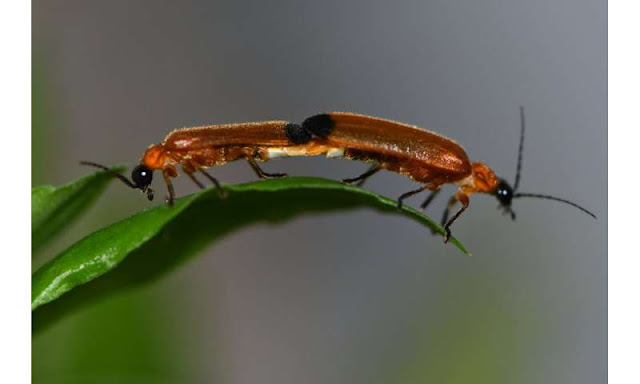Pyrocoelia analis from Tunchang, Hainan, China.
Credit: Chengqi Zhu
Ying Zhen and colleagues put the conventional wisdom to the test by compiling a family tree of fireflies and tracing the evolution of the chemical compounds that makes fireflies toxic: lucibufagins.
The team collected fresh samples for 16 species of Lampyridae from diverse locations across China, along with two related species, which they analyzed along with preexisting collections and genetic data. In total, the authors compiled genomic level data from 41 species. For each species, the authors also looked for lucibufagins using liquid chromatography-mass spectrometry.
The team were able to show that the lucibufagins are only found in one subfamily of fireflies, whereas bioluminescence is found widely across the entire family, strongly suggesting that the toxin evolved after the development of bioluminescence. So why did fireflies first begin to shine?
Abscondita anceyi from Wolong National Natural Reserve, Sichuan, China.
Credit: Chengqi Zhu
Absondita sp. from National Nature Reserve of Mount Tianmu, Zhejiang, China. Credit: Dongdong Xu
The substrate of firefly bioluminescence, luciferin, has previously been shown to have antioxidant properties. Ying Zhen and colleagues found that firefly ancestors evolved and diversified during a historical period when atmospheric oxygen levels continued to rise from a historical low after the Toarcian Oceanic Anoxic Event.
Time-calibrated maximum likelihood phylogeny of 41 beetles based on 1,353 orthologs nucleotide sequences. Node when firefly lucibufagins first evolved is marked by a molecule and the most recent common ancestors of Lampyridae is marked with a firefly cartoon. Numbers over the nodes are estimated median divergence time in millions of years ago. Fossil cartoons on the nodes represent the three fossil calibrations used. The color bar located at the bottom shows historical levels of oxygen.
Credit: Zhu et al
The authors also note that glowing millipedes are thought to have initially evolved bioluminescence to cope with oxidative stress in hot, dry environments and suggest that perhaps the fireflies followed a similar path.
Recommend this post and follow
The Life of Earth





No comments:
Post a Comment
Stick to the subject, NO religion, or Party politics